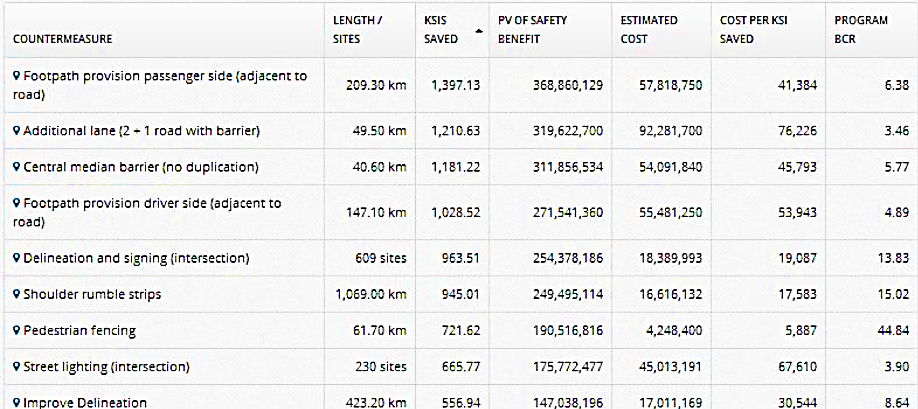
Road Safety Manual
A manual for practitioners and decision makers
on implementing safe system infrastructure!

Road Safety Manual
A manual for practitioners and decision makers
on implementing safe system infrastructure!
The previous chapter discussed how to identify risk, while the earlier part of this chapter discussed the use of effective interventions to address the risks that have been identified. The next important step is to determine the priority of different treatments. In most situations, there are likely to be financial constraints, which means that not all worthy projects or programmes can be funded. Therefore, a method is needed to identify which projects/programmes should be undertaken as the highest priority. There are also likely to be several options for addressing a risk, and it is necessary to see which of these options will produce the best safety benefit for the cost. Economic appraisals or evaluations provide a comparison basis which can be used for prioritising, comparing and selecting road safety interventions. They help identify measures that yield the highest social return.
At the strategic level, it may also be necessary to establish the relative importance of proactive and reactive measures and decide on the budget proportion that will be allocated to each approach. The guidance provided in this chapter can be used at the strategic, programme or project level.
PIARC (2012) has produced the State of the practice for cost-effectiveness analysis, cost-benefit analysis and resource allocation document, which provides comprehensive advice on methods to appraise projects and allocate resources. This document defines project appraisal as an assessment of the value of a project in order to establish whether the project meets the country’s economic and social objectives. Evaluation approaches include cost-effectiveness analysis (CEA) and cost-benefit analysis (CBA) (also referred to as benefit-cost analysis (BCA)). The outcome indicators from this analysis (BCR, NPV, FYRR and IRR) are discussed in Assessment Criteria in Priority Ranking Methods and Economic Assessments. The following sections provide a summary of some of the key material on these issues.
Cost-effectiveness analysis involves comparing the cost of a proposed countermeasure with the outcome or effect it produces. Within cost-effectiveness, projects are ranked and screened according to their cost and effectiveness in improving road safety or achieving policy objectives. Effects are generally expressed in non-monetary units, e.g. the change in the number of crashes. Cost-effectiveness is mainly applied when comparing alternative projects, programmes and policies with a similar outcome. The cost-effectiveness is expressed as the cost-effectiveness ratio (CER), which is calculated by dividing the number of crashes prevented by the cost of the measure.
Cost-benefit analysis uses monetary values to compare total benefits with total costs of any given policy, programme or project. It is mainly used to determine the worth of an investment based on the total benefits and costs of the investment, and to compare a project with any alternative projects. Cost-benefit analysis is used in road safety economic appraisal to help build a business case and secure funding for different projects or programmes. It enables comparisons between alternative road safety measures, identifying both the cost and the benefits to society as a whole to determine if the project should be undertaken and to establish priorities for approved projects. This, in turn, encourages the efficient allocation of limited resources to competing policies.
Yannis et al. (2008) provide a useful summary of cost-effective infrastructure interventions in an analysis for the Conference of European Directors of Roads (CEDR). They examined 55 road infrastructure investments, including reviews of both the costs and benefits of each. Based on this analysis they identified several best practice examples that should be considered in the efficient planning of investments. The cost-effective intervention options were:
The key data requirements or parameters for estimating countermeasure benefits and costs are as follows:
Initial costs refer to implementation costs (e.g. installation, material and labour costs) for each countermeasure. The costs differ by road environment type, traffic volumes, local environment, local labour costs, and availability of materials. There is greater uncertainty surrounding implementation costs in most LMICs as the information is not readily available. The Road Safety Toolkit (http://toolkit.irap.org) outlines general cost levels for different countermeasures. These values can be used as indicative measures where the treatments have not been implemented before or in cases where the cost information is not readily available.
Annual maintenance and operating costs refer to routine and periodic maintenance costs and running costs. The level and regularity of maintenance and associated running costs depend on the countermeasure.
Some countermeasures may have a residual value if they are removed. For example, an intersection may be temporarily equipped with traffic signals for a number of years until a by-pass is completed, and after completion, lower subsequent traffic flows may warrant the removal of the traffic signals. If the countermeasure asset can be used elsewhere, the recovery of this cost should be taken into account. However, in most cases, any residual value is likely to be negligible.
A countermeasure’s service life refers to the time period over which a treatment will deliver safety benefits before major rehabilitation or replacement is required. It varies with:
For projects involving multiple treatments, e.g. network or national blackspot programmes, the service life applied is that of the longest-lived component. Table 11.2 gives example maximum treatment lives for different countermeasures. Given the issues listed above, this is likely to vary substantially for individual projects. As an example, in the US, the treatment life for line-marking is expected to be one year, especially in States that experience snow and ice conditions.
| Treatment type | Recommended maximum treatment life (years) |
|---|---|
Grade separation | 50 |
Realign curve | 35 |
Stagger or realign intersection | 35 |
Roundabout | 30 |
Median barrier | 30 |
Shoulder sealing or widening | 25 |
Add or widen lane (including overtaking lane) | 25 |
Provide acceptable superelevation | 25 |
Railway level crossing barriers | 20 |
Median island (or other island) | 20 |
Guardrail (roadside) | 20 |
Street lighting | 20 |
Remove roadside hazard (trees, pylons, etc.) | 20 |
New traffic signals (hardware and/or software) | 15 |
Improve sight distance by removing impediment on main road | 10 |
Edge marker posts (guideposts) | 10 |
Skid resistant surface | 10 |
Signs (advisory, warning, parking, speed limit, etc.) | 10 |
Raised reflectorized pavement markers | 5 |
Line-marking (thermoplastic) | 5 |
Line-marking (paint) |
Source: Adapted from Turner & Comport (2010).
The main benefits of road safety projects are expressed in terms of monetary savings from crash reductions or prevention of casualties (fatalities and injuries) over a given number of years.
Treatment effectiveness can be expressed as crash modification factors (CMFs). Several comprehensive resources that provide CMFs for different interventions are provided in Intervention Option and Selection, including the CMF Clearinghouse database (http://www.cmfclearinghouse.org/) and the Road Safety Toolkit (toolkit.irap.org). As also discussed previously, the effectiveness and magnitude of crash changes can vary according to their context/environment.
In cases where several treatments are applied at the same location (multiple countermeasures), estimates of overall benefits need to be made. Some approaches have only included the crash savings from the primary or main treatment, but it is preferable that total benefits be calculated. Care needs to be taken to ensure that benefits are not counted more than once for interventions that improve safety in similar ways. For example, to address crashes at a curve, interventions such as advanced warning signs, audio-tactile edgelines, and improved road surface friction may be applied. The total benefit of these treatments will not equal the sum of benefits for each treatment, as each is alike in terms of its effect on crashes. For situations where treatments are linked, an adjustment needs to be made. Although several complex approaches have been devised to calculate the total benefit from multiple treatments, the simple approach outlined by Shen et al. (2004) will usually suffice. They suggest a multiplicative formula similar in form to that shown below:
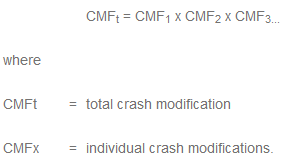
As an example, if three countermeasures are being considered in one location, with CMFs of 0.6, 0.75 and 0.8, the results would be as follows:
CMFt = 0.6 x 0.75 x 0.8
= 0.36, or 36% of crashes will remain (i.e. a 64% reduction in crashes).
A 64% reduction in casualties is obviously less than the 85% reduction that would be calculated if each reduction was added together.
Roberts and Turner (2007) were able to compare safety benefits at locations where packages of treatments were used, with locations where the same treatments were used but as single treatments. By applying the above formula, they identified that this approach tended to overestimate the true benefit of treatments. They suggested the results be multiplied by 0.66 to provide a more conservative approach (for the above example, this would produce a result of 42% reduction).
For a detailed discussion on the effectiveness of multiple treatment projects, see AASHTO (2010), iRAP (2013), and Elvik (2007).
The benefits resulting over time from safety countermeasures are estimated by placing an economic value on crashes, and applying this to the expected reduction in crashes. Values should not be derived on a project-by-project basis, but should be set at the national level by transport economists and updated annually.
This economic value, referred to as the social cost of crashes, is the value of property damage caused by vehicle crashes, medical and ambulance costs, insurance and administration costs, loss of output costs, police costs, and human costs associated with the pain and suffering caused by death and injury. The different cost components are outlined in Table 11.3.
| Costs per casualty |
|---|
Lost productivity (depending on the underlying hypothesis, gross loss of output or loss of output net of consumption) |
Human costs (loss of life expectancy, physical and mental suffering of the victim, mental suffering of the victim’s relatives and friends) |
Medical costs (medical rehabilitation) |
Non-medical rehabilitation |
Other economic costs. |
| Costs per crash |
Damage to property (including environmental damage) |
Administration costs |
Other costs (e.g. congestion costs, vehicle rental costs). |
Source: PIARC (2012).
There have been many projects and considerable debate about the best way to determine crash costs (Hills & Jones-Lee, 1983; Alfaro et al., 1994; Jacobs, 1995), but it is now generally accepted that only two methods should be considered – the willingness-to-pay (WTP) approach and the human capital (HC) approach. These approaches are summarised in Table 11.4.
| Approach | Description |
|---|---|
Human capital approach (HC) | Measures the impact of crash fatalities and injuries on present and future national output. The main attribute of HC is the present value of gross earnings (before tax). Direct costs such as vehicle costs, medical and emergency services costs are also added to the earnings estimate. In other cases, costs of human pain, suffering and grief are also included in the value of fatalities and injuries. |
The attributes can therefore be summarised as the value of future output loss due to casualties sustained in road crashes and the cost of resources spent to attend to the effects of the crashes. | |
Willingness-to-pay approach (WTP) | The estimates under the HC approach are average values rather than individual ones. |
Measures the amount individuals are willing to pay in order to reduce the risk of death and/or injury. Estimates are obtained from either revealed preferences (observing situations where individuals trade-off wealth or income for risk of death or injury) and stated preferences (individuals indicate how much they are willing to pay in order to reduce risk of death or injury based on hypothetical situations or questions). |
Source: Based on Hills and Jones-Lee (1983).
For a detailed description and discussion of the HC and WTP approaches, see PIARC (2013), HEATCO (2006), Transport Research Laboratory (1995), and Asian Development Bank (2005). Although both approaches are widely used, the willingness-to-pay (WTP) assessment method is generally recommended (DaCoTA, 2012; McMahon & Dahdah, 2008).
Costs must be determined for crashes of varying levels of severity, usually fatal, serious, slight or minor, and property damage only. These severity levels have been defined in Effective Management And Use Of Safety Data where it was indicated that a fatal crash involved a situation where at least one person died within 30 days of a crash; while a serious injury crash involved at least one person admitted to hospital, but there were no deaths. A minor crash indicates that at one person received some form of injury, but no one was killed or seriously injured.
For the purpose of prioritising actions aimed at reducing crash frequency, a single average cost for all injury crashes is generally considered sufficient, particularly since it is difficult to predict the specific severities of accidents that might be prevented.
Costs are always based on average values, and in some countries, are also determined for broad road categories (e.g. urban, rural, freeway). The social cost of crashes provides an estimate of the economic burden that different crash and injury types place on the economy. For illustrative purposes, an example of costs by road category and accident severity for the UK in 2012 is shown in Table 11.5.
It can be seen that costs increase from built-up roads to non-built-up roads to freeways, indicating the effect of greater speeds on crash severity levels. It can also be seen that there are approximately ten-fold increases in costs between severity levels. That is, the cost of a slight crash is about ten times that of a damage only crash, a serious crash is about ten times that of a slight crash, and a fatal crash is about ten times that of a serious crash.
| Cost per casualty UK £ (US$) | Cost per crash UK £ (US$) | ||||
|---|---|---|---|---|---|
| Crash/casualty type | All roads | Urban roads | Rural roads | Motorways | All roads |
Fatal | 1,703,822 ($2,650,064) | 1,914,229 ($2,977,322) | 1,920,372 ($2,986,877) | 1,924,341 ($2,993,051) | 1,917,766 ($2,982,825) |
Serious | 191,462 ($297,793) | 218,109 ($339,238) | 220,524 ($342,998) | 229,358 ($356,735) | 219,043 ($340,697) |
Slight/ minor | 14,760 ($22,957) | 22,773 ($35,421) | 24,559 ($38,199) | 27,857 ($43,328) | 23,336 ($36,296) |
All injury crashes | 50,698 ($78,853) | 62,250 ($96,821) | 109,415 ($170,180) | 74,471 ($115,830) | 72,739 ($113,136) |
Damage only | 1,935 ($3,010) | 2,830 ($4,402) | 2,720 ($4,230) | 2,048 ($3,185) | |
Source: Adapted from Department for Transport (2013).
Calculation of crash costs is generally undertaken at the country level, and development of an accurate figure can be a complex process regardless of which method is used. If no figure is available at the country level, a simple method for obtaining the value of crashes, especially in the absence of the data required for the HC and WTP approaches, is the iRAP ‘rule of thumb’ (McMahon & Dahdah, 2008). This method uses the information from countries that have already carried out WTP calculations, and analyses the relationship between the value of statistical life (VSL) and gross domestic product (GDP) per capita.
The assumptions are (McMahon & Dahdah, 2008 Table 10):
The approach was originally developed using WTP values from a limited number of LMICs. These values were recently updated using a larger dataset (Milligan et al., 2014). The update showed that the rule of thumb tends to underestimate VSL for countries with GDP per capita above $7000 (Milligan et al., 2014).
Generation of crash costs can be a significant issue in LMICs, even with the availability of crash cost estimates, or when using the ‘rule of thumb’. Due to low GDP per capita in many countries, the crash costs can be low, while the cost for installing engineering treatments can remain high. The example (Box 11.5) below illustrates this issue using an example from Papua New Guinea.
When compared with a ‘base option’ that involved minimum surface repairs only and had an almost six-month delay in response between the emergence of serious pavement defects and their repair; the combined NRRSP/KRGMP inputs, if continued over a twenty-year period, could deliver economic benefits of approximately K1.15 billion (approximately US$0.5 billion) with a marginal BCR of approximately 5, excluding crash cost savings. This resulted from prompt pavement repairs, with a monthly cycle of reactive surface maintenance, drainage and shoulder maintenance, and periodic resurfacing, and localised pavement repairs. Where the base option was changed to incorporate pavement strengthening or reconstruction when conditions were seriously deteriorated, the net benefits declined to between approximately K87 million and K629 million, with a maximum marginal BCR of 4.6.
Crash rates were also investigated and revealed a potential for reduction in crash risk by up to 30% from the current figures of approximately 4,000 casualties per year. This reduction was based on an assumed 15% reduction due to improved road surface condition, and a combination of factors such as improved visibility and shoulder conditions.
The total cost of crashes is given by the number of crashes of each type, multiplied by their unit cost of crashes. On this basis, the total cost of crashes is K24.4 million annually. To place this in proportion, it is equivalent to approaching a 2% reduction in all other costs; i.e. crash reductions will boost the cost saving due to improved maintenance by up to 2%.
The above figures are clearly impacted by the value of statistical life applied, noting that the value used is considerably less (by a factor of 42) than that applied in Australia. Furthermore, the relative crash rate for the Highlands Highway is approximately four times the base crash rate of typical Australian roads with similar operating conditions (McLean, 2001; Turner et al., 2009), which is not unexpected.
Consequently, the estimated gross crash costs are approximately 10% of those calculated for similar conditions in Australia. This is likely to have significant consequences for the economic justification of crash mitigation measures, and warrants closer study.
Aspects that require consideration include: a) the value of statistical life, with the possibility that current ‘lost output’ methods take insufficient account of the extended family who are often supported by a ‘bread-winner’ in traditional societies in PNG and elsewhere. The loss of income has potential to affect the education and income-earning opportunities of a generation ; b) the need to account for real increases in income growth in LMICs, and the consequent increase in ‘real’ crash costs; c) the challenge of identifying affordable engineering treatments to mitigate crash risks, noting that the actual cost of road treatments delivered in LMICs and HICs are almost comparable (probably a maximum of 2 to 3 times different), whereas the value placed on the social cost of crashes is some 40 times less.
Alternatively, the value of different injury severities can be derived using quality adjusted life years (QALYs) and disability adjusted life years (DALYs). QALYs measure the value of a fatality prevented, taking into account the quantity and quality of life. They place a weight of one for a year of perfect health and zero for death. DALYs on the other hand, measure the quality of life lost or loss of life years due to illness or injury. They account for the burden of injury or illness and can also be used to measure property damage. DALYs and QALYs are widely used in health economics and very rarely in road safety. An example application of DALYs and QALYs in Colombia road safety is outlined in Box 11.6.
Using the well-established relationship between the value of statistical life and GDP per capita, they used different rules of thumb to estimate the cost of crashes using DALY estimates. These rules are outlined below.
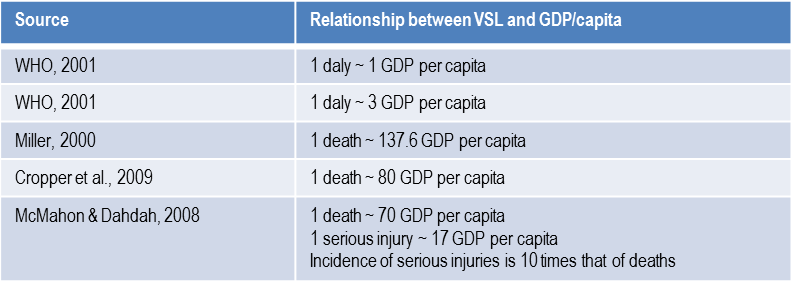
The unit costs used in the estimation are outlined below.
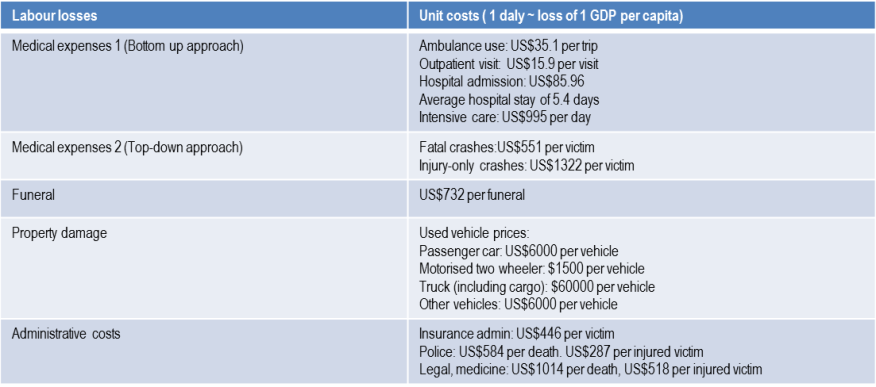
In any economic road project assessment, it is important to identify a base year from which all future costs and benefits can be assessed. This is because the value of a dollar received in the future is less than the value of a dollar now (also referred to as the ‘time value of money’). The discount rate is used to compare benefits and costs received at different points in time over a project’s treatment life, converting future benefits and costs to present values.
The choice of discount rate can have significant effects on the desirability and selection of projects, especially where benefits and costs accrue later in the treatment’s life. A higher discount rate reduces the value of benefits and costs occurring later in the treatment’s life, favouring projects where benefits occur early in the project. The World Bank recommends present value calculations at 12% discount rates (2014 values) be included in road project business case submissions (see PIARC, 2012; AASHTO, 2010). It is important to note, however, that this value is not necessarily relevant for every country, and the discount rate actually used can be significantly different. For instance, the discount rate is close to 5% in several western European countries.
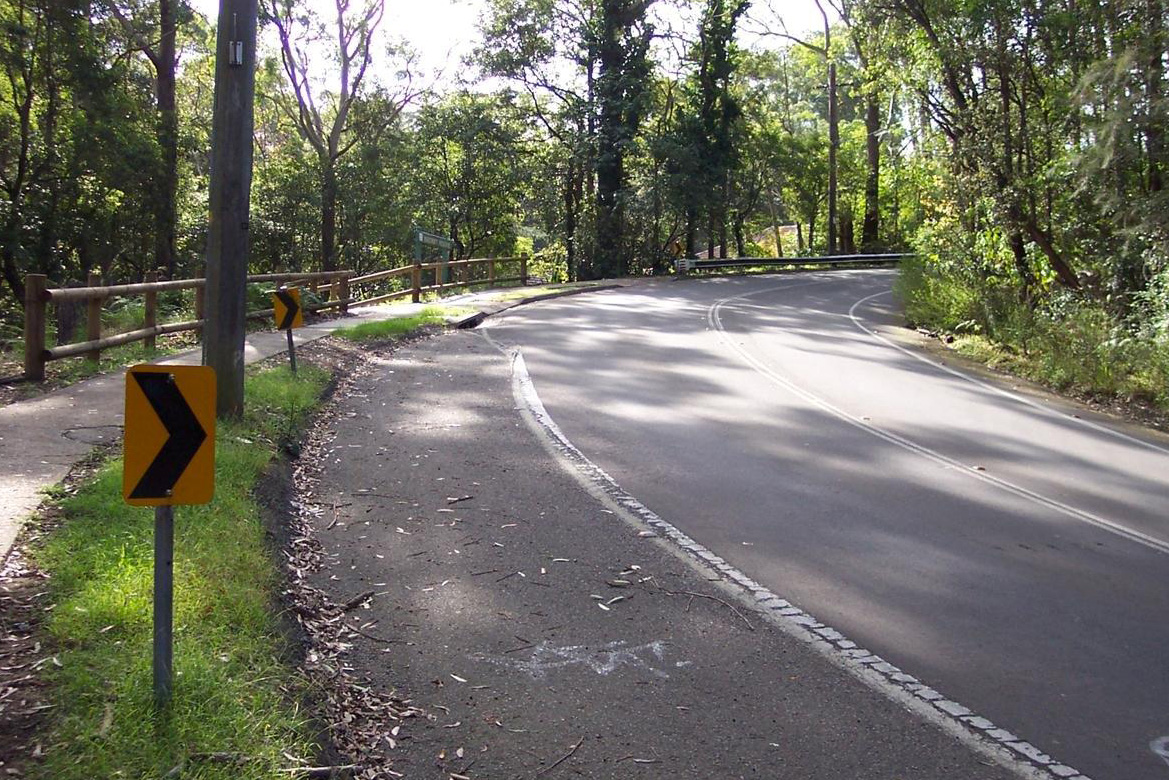
As indicated above, the standard approach for the ranking of treatments is to carry out a cost-benefit analysis, i.e. to compare the estimated benefits of each scheme (in terms of the value of crashes that will be prevented) in relation to its costs (implementation, maintenance, etc.). The treatments are then prioritised in accordance with the best economic returns.
As previously mentioned, estimating likely crash reductions resulting from remedial work is often difficult, because it can only be based on previous experience with similar schemes (Turner & Hall, 1994; Kulmala, 1994; Mackie, 1997).
The selection of countermeasure options is based on the first year rate of return (FYRR), the internal rate of return (IRR), the benefit-cost ratio (BCR), and the incremental benefit-cost ratio (IBCR), as well as net present value (NPV). However, the two main indicators in assessing a project or treatment are the BCR and the NPV. These measures indicate whether the benefits of the proposed treatment outweigh the costs, and if the preferred treatment has the greatest net social benefit.
This is simply the net monetary value of savings and drawbacks anticipated in the first year of the scheme, expressed as a percentage of the total capital cost.

Note that the last two elements might be considered to be small, particularly for low-cost schemes, and are often ignored.
This is not a rigorous evaluation criterion for prioritisation since it ignores any benefits or changes in maintenance costs after the first year. However, it is very simple to calculate, and given that road safety engineering schemes often produce first year rates of return in excess of 100%, more sophisticated decision criteria may not be necessary. This method usually yields high values with low-cost schemes but with relatively small crash savings, and for this reason it is less consistent with the Safe System approach.
The FYRR can also be used to assess the timing of a particular project by comparing it with the discount rate. If the FYRR is greater than the discount rate, the project can, in theory, proceed. This says nothing, however, of how it compares with other projects. If the FYRR is less than the discount rate, the project should, at the very least, be postponed.
More detailed assessments will be needed for schemes where crashes and traffic levels are expected to change substantially from year to year. For example, a scheme with an 80% FYRR may not be worthwhile if subsequent road closures due to the construction of a new road limit the benefit to just one year.
Another important criteria used for assessing costs and benefits of highway schemes is the internal rate of return (IRR). This is the discount rate that makes the NPV equal to zero or makes the BCR equal to one. A theoretical example of how the discount rate affects the NPV of a project is shown in Figure 11.6
. 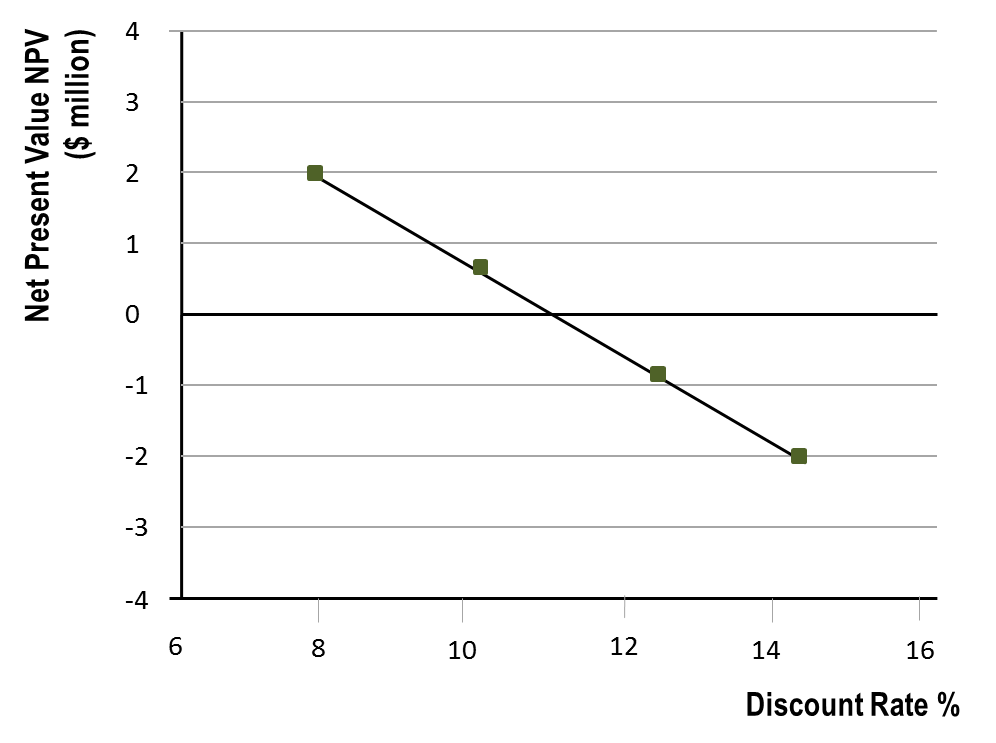
At discount rates of 8% or 10%, the project has a positive NPV, while it is negative at 12% or 14%. The NPV is zero at 11% discount rate, which is known as the internal rate of return (IRR). The IRR is preferred by multilateral aid agencies, such as the World Bank, because it avoids the use of local discount rates which, depending on their value, can significantly affect the NPV or NPV/PVC ratio. The IRR is not particularly useful for ranking projects, but is included for comprehensiveness.
Benefit cost ratio (BCR) is defined as the present value of benefits (PVB) divided by the present value of costs (PVC):

When the NPV of any given project is positive, the BCR is greater than one. The greater the BCR, the higher the benefits are. The BCR is used to rank projects where there is a budget constraint, and it serves as an indicator of a project’s economic efficiency.
The IBCR involves ranking a pairwise comparison of all alternatives with a BCR greater than one in order to determine the marginal benefit obtained for a marginal increment in cost. Then, after eliminating all schemes with a BCR of less than one, the schemes are listed in order of ascending cost and the marginal BCR is determined by a pairwise comparison of alternatives, starting with the lowest and second-lowest cost alternatives. That is:
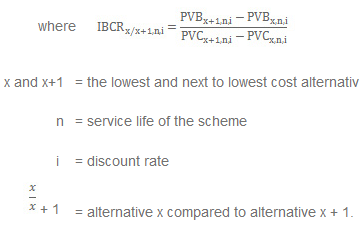
If the IBCR is greater than one, the alternative x+1 is preferred, since the marginal benefit is greater than the marginal cost. Conversely, if the IBCR is less than one, alternative x is preferred. The preferred option is then taken and the pairwise comparison is continued until only a single alternative remains, which should then be the most economically desirable of all the options considered.
However, Ogden (1996) concludes that the BCR approach is more cumbersome to use than the NPV approach and may produce more ambiguous and misleading results depending on how benefits and costs are defined. It is of particular note that low-cost measures are typically favoured when using BCR as the basis for selection. For example, installing advanced warning signs are likely to have a limited (but beneficial) effect on severe crash outcomes, but due to the low cost of installation, they are likely to produce a high BCR. In contrast, roadside barriers are likely (in the right situation) to have a significant effect on reducing fatal and serious crash outcomes. However, given the greater cost for installation and maintenance, the BCR is likely to be lower. The aim of road safety is to produce a net reduction in fatal and serious injury. Using solely the BCR approach may produce outcomes that are inconsistent with this objective. Therefore the NPV/PVC approach in association with BCR is much preferred.
This type of evaluation expresses the difference between discounted costs and benefits of a scheme, which may extend over a number of years. As stated earlier, future benefits must be adjusted or discounted before being summed to obtain a present value. Changes may also take place over the life of the scheme which will affect benefits in future years.
Let us assume (for ease of calculation) that the current rate used by the government for highway schemes is 10%, which in the prevailing economic climate might be considered as somewhat high in most countries. This means that $100 in benefits accruing this year will be worth 10% less if it accrues next year. A further year's delay will reduce the benefit again, and so on. These figures can be summed over the life of the scheme to obtain the present value of benefits (PVB).
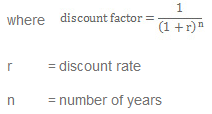
Net present value is defined as the difference between the discounted monetary value of all the benefits and costs of a particular project or measure. The NPV is expressed as the PVB minus the PVC. A positive NPV indicates an improvement in economic efficiency compared with the base case.
With respect to implementation priorities, the economic criteria for scheme assessment using the NPV approach are:
Care needs to be taken in using NPV as the only investment criterion, since it tends to indicate projects with higher costs.
The choice of assessment criteria depends primarily on available data, as well as the scope of the treatment. The different assessment criteria provide information on the project. The NPV provides information on the total welfare gain over a project’s treatment life; the BCR highlights the relationship between the present value benefits and implementation costs of a project; while the IRR shows the rates at which benefits are realised after investing in a countermeasure (PIARC, 2012).
The NPV is the preferred criterion as it provides an estimate of the absolute size of the treatment’s net social benefit. The BCR on the other hand provides the relative size of the costs and benefits of a treatment and depends on the classification of the project’s impacts. Table 11.6 provides guidance on when to use the different criteria.
| Criterion | ||||
|---|---|---|---|---|
| Budget | Decision context | Net present value (NPV) | Benefit-cost ratio (BCR) | Internal rate of return (IRR) |
Unconstrained budget | Accept/Reject decision | Accept if NPV is non-negative ✓ | Accept if BCR exceeds/equals unity ✓ | Accept if IRR exceeds/equals the hurdle rate ✓ |
Option selection | Select project with highest non-negative NPV ✓ | No rule exists ✘ | No rule exists ✘ | |
Constrained budget | Accept/Reject decision | Select project such that NPV of project set is maximised subject to budget constraint ✓ | Rank by BCR until budget is exhausted or BCR cut-off reached ✓ | No rule exists ✘ |
Option selection | Highest NPV subject to budget constraint ✓ | No rule exists ✘ | No rule exists ✘ | |
Source: Austroads (2005).
For a comprehensive step-by-step approach on economic appraisals or evaluation, as well as a summarised discussion of the assessment criteria, see PIARC (2012), EU (2006), and HEATCO (2006). Box 11.7 provides an example economic evaluation from Belize.
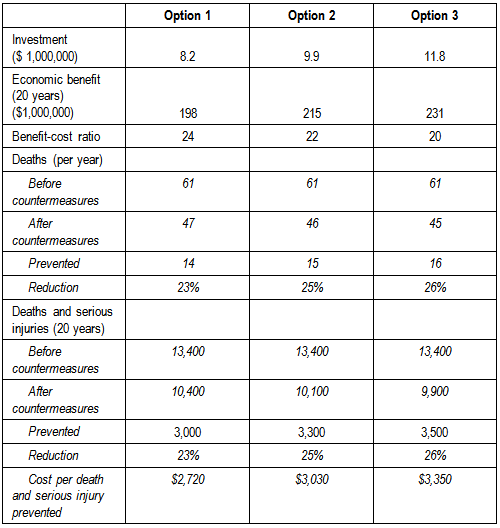
The development of several options as in this example is fairly typical for road safety projects. This will help determine which combination of treatments will deliver the greatest benefit for the available funding. In this case, and following discussions with the project stakeholders, the options were adjusted with a lower cost option selected, and the benefits and costs recalculated. The estimated NPV of the project, using very conservative crash cost values, is US$6.1 m and the economic rate of return (ERR) is 28.8%. The ERR is well-above the Caribbean Development Bank’s cut-off rate of 12.0%
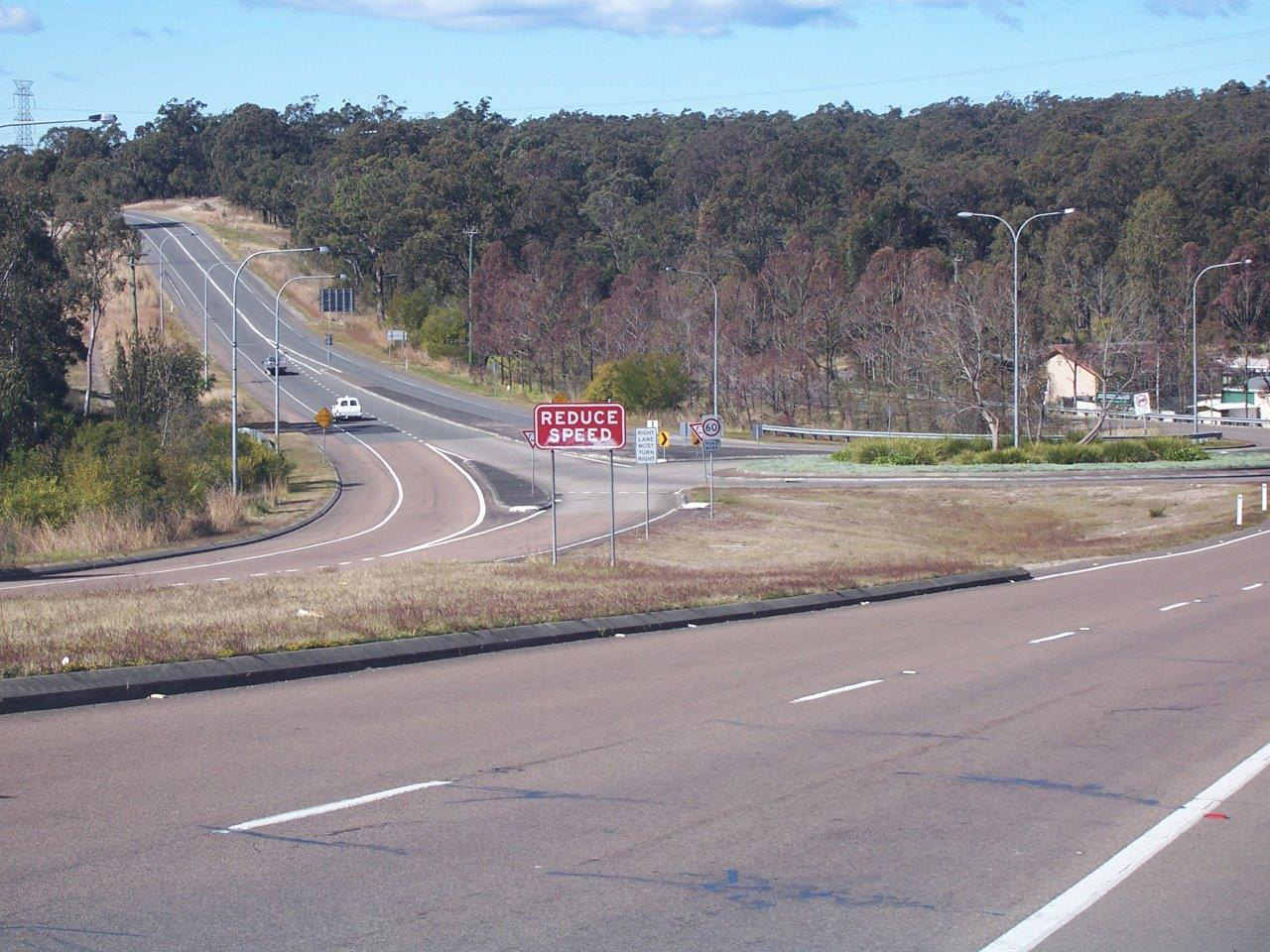
A variety of tools assist with the economic appraisal process in road safety. Some examples are provided below.
SafetyAnalyst (also discussion in Management Tools) includes an economic appraisal tool developed by the American Association of State Highway and Transportation Officials (AASHTO; see Harwood et al., 2010). It assesses whether countermeasures for a specific highway site are economically efficient. The tool allows the user to specify the costs, traffic volumes, and all other data inputs. It also provides default values for the specified treatment, which can be used in the estimation. The user can specify the economic appraisal to be performed, with options for cost-effectiveness analysis, benefit-cost ratio or net present value. The effectiveness measures are obtained from observed, expected and predicted crash patterns at the specific site. The countermeasures and sites are ranked using the Priority Ranking Tool component of SafetyAnalyst, which uses the same measures obtained by the economic appraisal tool and also provides the optimal option given budget constraints. The choice of prioritisation criteria lies with the user.
COBALT is an economic appraisal tool developed in 2012 by the UK Department for Transport. It was derived from the broader transport appraisal tool, COBA (Cost Benefit Analysis tool). COBALT focuses solely on road safety appraisals using the same CBA approach as COBA as outlined in DfT (2011).
While New Zealand does not have a dedicated road safety economic appraisal tool, the Economic evaluation manual (EEM) (New Zealand Transport Agency 2013) provides clear guidance and templates that can be used in the evaluation process. The EEM is a guidance tool outlining procedures for economic evaluations of transport investment proposals. It provides descriptions of basic concepts in economic evaluations and simple and detailed procedures for evaluations. The simple procedures are aimed at low cost activities while the detailed procedures are for large scale evaluations. Step by step methodologies for evaluating benefits and costs are also provided through downloadable spreadsheets.
There are different spreadsheets for different evaluations. The road safety promotion spreadsheet contains six procedural worksheets and four other worksheets for working notes, cost estimates and sensitivity analysis. Worksheet 1 is a summary of general project information and data used for the evaluation. Worksheet 2 is used for calculating the present value of project costs, worksheet 3 is used for calculating the social cost of crashes per person and worksheet 4 is used for calculating the present value of project benefits. Worksheet 5 is used to calculate the BCR per head. The cover worksheet is a summary of all the information and calculations in the spreadsheet. For each of the steps, there is guidance offered on the necessary information and input data.
European guidance on economic appraisals and prioritisation of road safety countermeasures is also available to practitioners. Examples of this include European Road Safety Observatory (ERSO- http://www.erso.eu/), Developing Harmonised European Approaches for Transport Costing and Project Assessment (HEATCO- http://heatco.ier.uni-stuttgart.de/), and Road Safety and Environmental Benefit-Cost and Cost-Effectiveness Analysis for Use in Decision-Making (ROSEBUD, http://partnet.vtt.fi/rosebud/).
The process applied by iRAP (Section 10.4.4) not only identifies problems and effective interventions, it also produces detailed business plans, including the cost-effectiveness of the interventions identified. An example from the Ukraine of one such investment plan is provided in Figure 11.7
